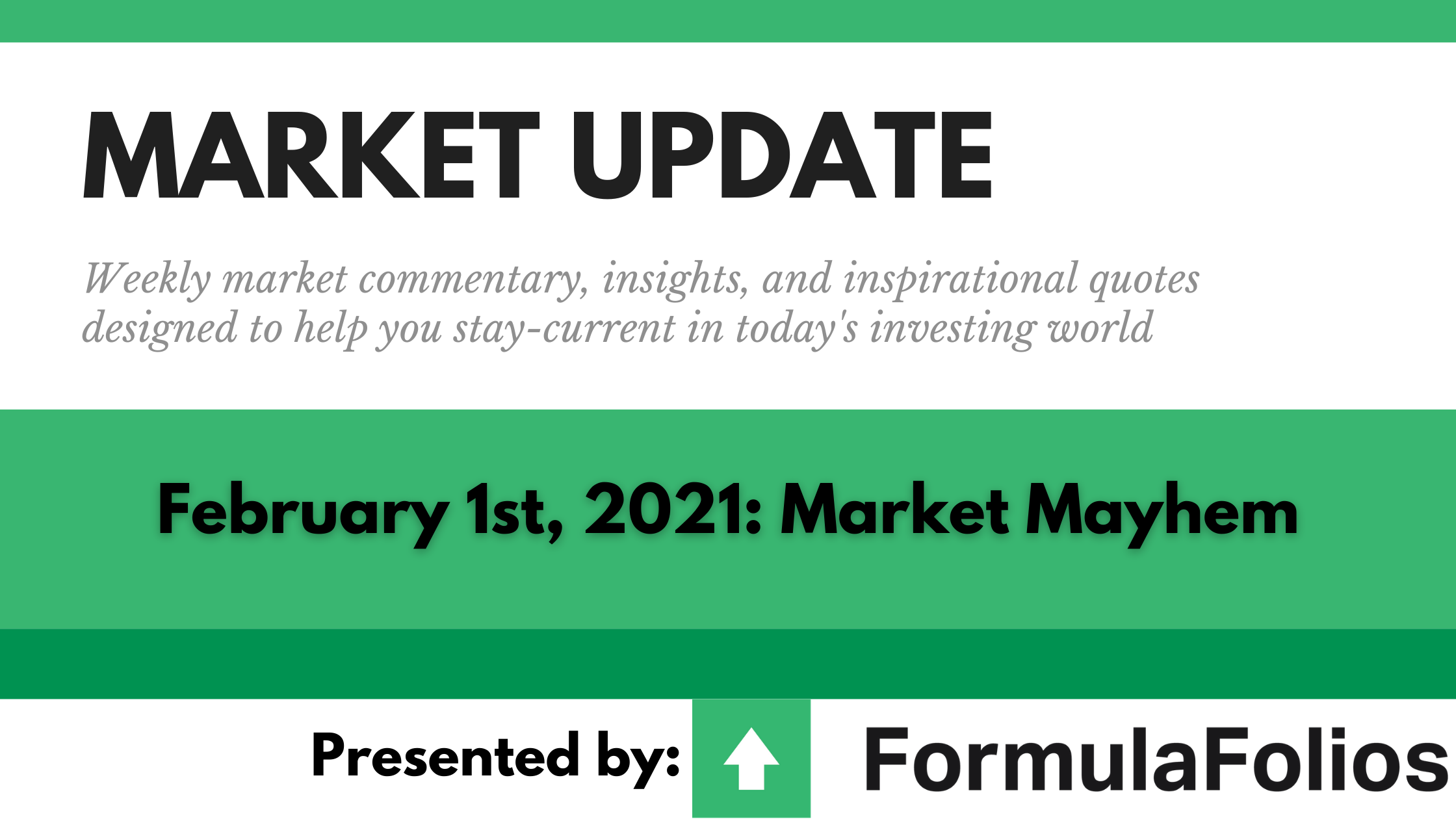Market Update: Strong Data
(Published Feb. 22nd, 2021)
Markets were mixed this week as a wide range of positive economic data...

(Published Feb. 1st, 2021)
Markets fell this week as Q4 GDP numbers came in slightly under expectations. Economists expected growth of 4.2%, but the actual figure of 4.0% disappointed a hopeful market. While 4.0% growth came in under expectations, it’s worth recognizing the speed of the economic recovery. In spring and summer 2020, few would have predicted that the U.S. was poised to return to 2019 output levels by as soon as mid 2021 if current trajectories hold, further highlighting the astonishing whipsawing that has taken place in the last year. In other economic news, unemployment claims beat expectations along with core durable goods orders, highlighting the continued progress in the economy. On the COVID-19 front, U.S. infections continue to recede. The 7 day moving average has dropped to roughly 150K daily infections for the first time since mid November.
Overseas, developed markets and emerging markets both fell. In spite of better than expected GDP in three of Europe’s largest economies, European markets still receded. Japanese markets also declined. Improving prospects against the pandemic should continue to help lift markets globally over time.
Markets fell this week as investors continue to assess the state of the global economy. Fears concerning global stability and health are an unexpected factor in asset values, and the recent volatility serves as a great reminder of why it is so important to remain committed to a long-term plan and maintain a well-diversified portfolio. When stocks were struggling to gain traction last month, other asset classes such as gold, REITs, and US Treasury bonds proved to be more stable. Flashy news headlines can make it tempting to make knee-jerk decisions, but sticking to a strategy and maintaining a portfolio consistent with your goals and risk tolerance can lead to smoother returns and a better probability for long-term success.

European economies have surprised analysts with better-than-anticipated Q4 GDP numbers. Europe reimposed harsh lockdowns during its second wave which began in the fall, and expectations were for damage to be much more significant in Q4.
Broad market equity indices finished the week down, with major large cap indices outperforming small cap. Economic data has been steadying, but the global recovery has a long way to go to recover from COVID-19 lockdowns.
S&P sectors returned exclusively negative results this week. Real estate and utilities outperformed, returning -0.15% and -1.14% respectively. Materials and energy underperformed, posting -5.03% and -6.62% respectively. Energy maintains its lead 2021 with a 3.63% return.


Oil fell slightly this week as the embattled commodity continues to stabilize. Energy markets have been highly volatile, but it appears that further price support may be on the horizon given recent developments. Demand is still low, but as vaccinations proliferate, lockdown restrictions in Europe as well as the U.S. should start to loosen, helping support recovery. On the supply side, operating oil rigs are still well under early 2020 numbers, but trending upwards. In addition to supply and demand, a weakening dollar is likely to have a large impact on commodity prices.
Gold fell this week as the U.S. dollar strengthened. Gold is a common “safe haven” asset, typically rising during times of market stress. Focus for gold has shifted to global macroeconomics surrounding COVID-19 damage and recovery efforts.
Yields on 10-year Treasuries fell this week from 1.086 to 1.066 while traditional bond indices rose. Treasury yield movements reflect general risk outlook, and tend to track overall investor sentiment. Treasury yields will continue to be a focus as analysts watch for signs of changing market conditions.
High-yield bonds fell slightly this week as spreads loosened. High-yield bonds are likely to decrease in volatility in the short to intermediate term as the Fed has adopted a remarkably accommodative monetary stance, vaccines have begun rolling out, and investors warm to economic risk factors, likely helping stabilize volatility.

Finding the best person or the best organization to invest your money is one of the most important financial decisions you’ll ever make.”
-Bill Gross
FormulaFolios has two simple indicators we share that help you see how the economy is doing (we call this the Recession Probability Index, or RPI), as well as if the US Stock Market is strong (bull) or weak (bear).
In a nutshell, we want the RPI to be low on a scale of 1 to 100. For the US Equity Bull/Bear indicator, we want it to read at least 66.67% bullish. When those two things occur, our research shows market performance is typically stronger, with less volatility.
The Recession Probability Index (RPI) has a current reading of 28.94, forecasting a lower potential for an economic contraction (warning of recession risk). The Bull/Bear indicator is currently 100% bullish, meaning the indicator shows there is a slightly higher than average likelihood of stock market increases in the near term (within the next 18 months).

It can be easy to become distracted from our long-term goals and chase returns when markets are volatile and uncertain. It is because of the allure of these distractions that having a plan and remaining disciplined is mission critical for long term success. Focusing on the long-run can help minimize the negative impact emotions can have on your portfolio and increase your chances for success over time.
This week will have the most recent hiring numbers as well the official unemployment rate. We will also see updated PMI numbers from both the services sector and manufacturing sector.
More to come soon. Stay tuned.
(Weekly Market Updates authored by Joshua Grow, MBA)
(Published Feb. 22nd, 2021)
Markets were mixed this week as a wide range of positive economic data...
(Published Jan. 19th, 2021)
Markets receded this week as December retail sales numbers...
(Published Feb. 8th, 2021)
Markets rose this week in spite of disappointing hiring in January....